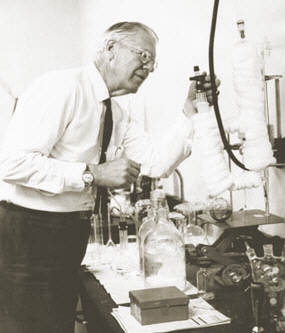History
Aerogels were first announced to the world in 1931 in Samuel Kistler's paper "Coherent Expanded Aerogels and Jellies". This was first seen in the science journal Nature. It is rumored that the cause of such a discovery was due to a bet between Kistler and his colleague Charles Learned. Their goal was to see if they could extract the liquid out of a gelatinous substance without causing sufficient shrinkage. http://www.aerogel.org/?p=399
http://www.aerogel.org/?p=399In order to adequately remove the liquid, Kistler used the process of supercritical drying. What he did was increase the temperature and pressure around the object to force the liquid into a 'supercritical fluid' state. He then dropped the pressure, thus causing the liquid to become a gas. This process avoided all damage to the structure of the gel. However, in order to avoid such dangers associated with the high temperatures, the exchange was done by using lower temperature liquids, allowing for the same result.
Kistler would continue his work with Aerogel, expanding beyond the basic Silica type of Aerogel to include elements such as Aluminum, Chromium, Tin, and Carbon based Aerogels. In the 1940's, he made the valiant attempt to market Aerogel. One of the setbacks Kistlers Aerogels was it's tendency to be brittle in the final stage. This factor and the fact it was expensive to make Aerogel would hinder Aerogel's attempts to be useful to everyone.
With the increased interest in space during the 70's and 80's, Aerogels would surmount its past obstacles and become an essential device to aid in the capture of flying space material that would otherwise be destroyed or vaporized if collided with a solid. This was proven in 2006 when NASA's Stardust mission returned with the Aerogel samples that had collected fragments from comet Wild 2 in 2004. NASA would also use Aerogel in the Mars Exploration Rovers in 2004.
Today Aerogel is used not only in space research,but had many practical uses on earth. Research of its uses continue, and one Malaysian scientist has discovered a way to make Aerogel from rice husks. According to NBC news "Halimaton Hamdan, a University of Cambridge-trained chemistry professor, says her process of making cuts the cost of producing Aerogel by 80 percent, making it so affordable that it could become a commonplace material with widespread use." The future now looks so much brighter for "Frozen Smoke"!!
To see more information on the different types of Aerogels, click here.
To read the NBC article about Aerogel from rice husks: http://www.nbcnews.com/id/23398379/ns/technology_and_science-innovation/t/high-tech-insulator-created-rice-husks/#.UpaGpOLO2So
